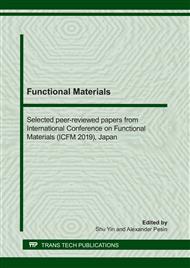p.39
p.45
p.51
p.59
p.65
p.73
p.81
p.87
p.95
Relationship of Structure and Surfactivity of Chitosan-Based Surfactants (SPDACS) and Application for Paclitaxel Solubilization
Abstract:
In this study, a new type of surfactant, N, N-dialkyl-3, 6-O-sulfopropyl chitosan (SPDACS) was prepared with two kinds of chitosan (Mw 10 and 50 kDa) and three kinds of alkyl groups (octyl, decyl and lauryl) respectively. The substitution degree of alkyl chain was around 1.50, and the substitution degree of sulfopropyl was around 1.70. The relationship of structure and surfactivity of chitosan-based surfactants were studied with six different structures of SPDACS.The results showed that the length of alkyl side chain and the molecular weight of chitosan main chain of SPDACS had distinct effect on the surface tension (γ) and the critical micelle concentration (CMC). CMC and γ could be reduced as the length of alkyl and the molecular weight of chitosan increased. For the products with 50 kDa of chitosan, the CMC decreased from 0.014 to 0.006 mg/mL, and γ down to 23.59 from 28.76 mN/m as the length of alkyl increased from 8C to 12C. The similar patterns happened for the products with 10 kDa of chitosan. The mean size of the blank micelles decreased with the growth of the length of alkyl, and the molecular weight of chitosan had little effect on the particle size. The zeta potential of all micelles were above -35mV which meant the micelles had good stability in the solution.The product of 5-SPDLCS (50 kDa, lauryl) with the best surfactivity were selected for the study of PTX solubilization. The optimal ratio of 5-SPDLCS/PTX was determined to be 1/1.1. The results showed the encapsulation effificiency (EE) and loading effificiency (LE) were 92.2 % and 50.36 % respectively. The solubility of PTX in water reached to 6.08 mg/mL. The solubility of PTX was 60,000 times higher than that of PTX (< 0.0001mg/mL) in pure water.
Info:
Periodical:
Pages:
65-70
Citation:
Online since:
May 2020
Authors:
Keywords:
Price:
Сopyright:
© 2020 Trans Tech Publications Ltd. All Rights Reserved
Share:
Citation:


